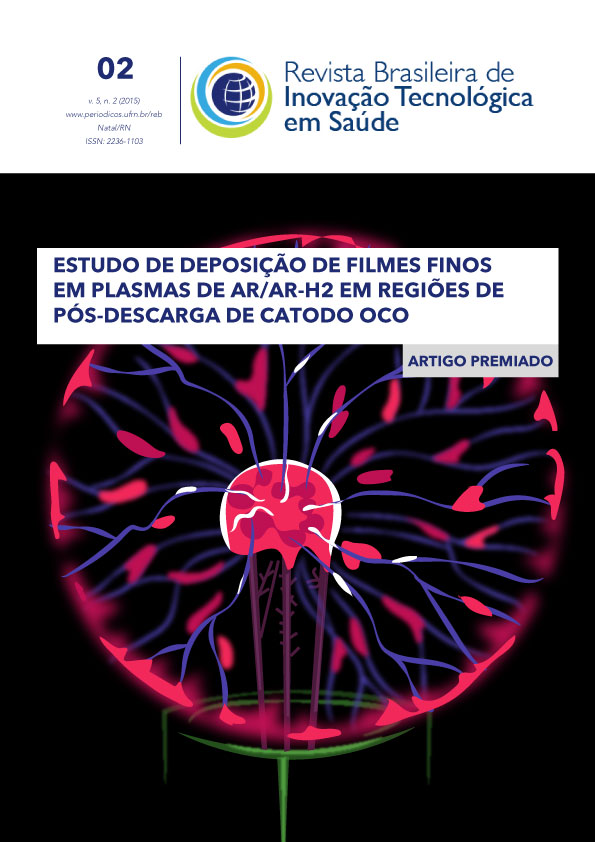ENSAIO BIOMECÂNICO DE FADIGA EM IMPLANTES DENTÁRIOS NITRETADOS A PLASMA EM CÁTODO OCO
DOI:
https://doi.org/10.18816/r-bits.v5i2.7251Resumo
Biomecânica é o estudo do movimento e do efeito das forças sobre os sistemas biológicos e em organismos vivos. Testes biomecânicos podem ser realizados com várias finalidades: para testar ou comparar diferentes métodos de fixação, a resistência de diferentes tipos de componentes, dentre eles, os implantes, além disso, estudar a distribuição das tensões no osso e o deslocamento, após aplicação de determinado método de estabilização de fraturas. Nesse trabalho foi realizado um ensaio biomecânico de fadiga com o objetivo de avaliar a eficácia do tratamento superficial aplicado ao implante nitretado a plasma em cátodo oco. A partir deste ensaio biomecânico de fadiga foi possível analisar: a força de escoamento, a força de ruptura do implante, a localização da falha e o momento fletor máximo para a força máxima de resistência à ruptura. Os resultados mostraram-se satisfatórios.Downloads
Referências
WENNERBERG, A.; ALBREKTSSON, T. Current Challenges in Successful Rehabilitation with Oral Implants. J. Oral Rehabil. 38(4), p. 286-294, 2011.
OLIVARES-NAVARRETE, R. et al. Osteoblast Maturation and New Bone Formation in Response to Titanium Implant Surface Features and Reduced With Age. J Bone Miner Res. 27(8), p.1773-1783, 2012.
KLEIN, M. O. et al. Submicron Scale-Structured Hydrophilic Titanium Surfaces Promote Early Osteogenic Gene Response for Cell Adhesion and Cell Differentiation. Clin Implant Dent Rel Res., In press. doi: 10.1111/j.1708-8208.2011.00339, 2011.
STADLINGER, B. et al. Surface-Conditioned Dental Implants: An Animal Study on Bone Formation. J Clin Periodontol 36(10), p. 882-91, 2009.
XUANYONG L.; PAUL K. C.; CHUANXIAN D. Surface Modification of Titanium, Titanium Alloys, and Related Materials for Biomedical Applications. Materials Science and Engineering: R: Report 47 (3-4), p. 49–121, 2004.
SILVA, M. A. M. et al. Surface Modification of Ti Implants by Plasma Oxidation in Hollow Cathode Discharge. Surface & Coatings Technology 20 (8), p. 612- 620, 2006.
SILVA, M. A. M. et al. Influence of Topography on Plasma Treated Titanium Surface Wettability. Surface & Coatings Technology, 2013
CHO S., PARK K. The Removal Torque of Titanium Screw Inserted in Rabbit Tibia Treated by dual Acid Etching. Biomaterials 24 (20), p. 3611–3617, 2003
ALVES JR, C. et al. Nitriding of Titanium Disks and Industrial Dental Implants using Hollow Cathode Discharge. Surface and Coatings Technology, 194 (2), p. 196-202, 2005.
SÁ, J. C. et al. Influence of Argon Ion Bombardment of Titanium Surfaces on the Cell Behavior. Surface & Coatings Technology 203, p. 1765-70, 2009
COELHO, P. G. et al. Argon-Based Atmospheric Pressure Plasma Enhances Early Bone Response to Rough Titanium Surfaces. J Biomed Mater Res. 100 (7), p. 1901-1906, 2012.
MISHRA, S.C et al. , B. J. Mater. Process. Technol. 132 (2003) 143.
SILVA, E. F. et al. Influência do Tipo de Hexágono e do Diâmetro do implante Osseointegrado na Distribuição de Estresse. Implant News 4 (5), p. 549-54, 2007.
ASSOCIAÇÃO BRASILEIRA DE NORMAS TÉCNICAS, ABNT NBR ISO 14801, Odontologia – Implantes – Ensaio dinâmico de fadiga para implantes odontológicos endósseos, Rio de Janeiro, 2012.








 Português (Brasil)
Português (Brasil) English
English Español (España)
Español (España)






